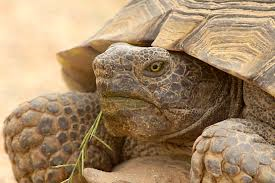Once upon a dread September, ‘twas in `11, I remember,
Desert tortoise was declared, not one well-known species, but even more;
By committee, in the city, finding distinctions itty-bitty, one endangered what a pity;
Signaling change from shore to shore, not like things had been before;
Why is this, with tortoise galore, now one called threatened, another in scores?
‘Tis the ravens, nothing more.
 Residents of the great southwest know the tale of the desert tortoise, listed as threatened under the Endangered Species Act in 1990, but changed dramatically in 2011. There was a fairly simple reason for the latter change. These elusive animals (which spend 95 percent of their lives underground and are thus rarely seen) were found to be much more common than previously assumed. The environmental lobby had suggested that the Sonoran and Mojave Deserts supported less than a tenth of the tortoises that once lived there. Better data over the years, however, counted as many as 300,000 of them, occupying much of that gigantic territory.
Residents of the great southwest know the tale of the desert tortoise, listed as threatened under the Endangered Species Act in 1990, but changed dramatically in 2011. There was a fairly simple reason for the latter change. These elusive animals (which spend 95 percent of their lives underground and are thus rarely seen) were found to be much more common than previously assumed. The environmental lobby had suggested that the Sonoran and Mojave Deserts supported less than a tenth of the tortoises that once lived there. Better data over the years, however, counted as many as 300,000 of them, occupying much of that gigantic territory.
In fact, such population estimates are little more than guesswork, based not on actual counts, but on computer models. And computer models are only as good as the data fed into them. Actual on-the-ground counts frequently produce very different conclusions.
For example, the National Wildlife Federation (NWF) once claimed 99 percent of all prairie dog habitat on the Great Plains had disappeared. No prairie dog town over 100 acres remained, they said. That was based only on computer modeling, so the State of Colorado spent $75,000 on aerial surveys to count prairie dogs. In fact, there were many times more animals in just one state than NWF said lived in the entire country. One town covered 10,000 acres, and in Colorado alone there was more occupied land than was claimed nationwide. We now know there are more than 30 million prairie dogs in ten states, and their numbers increasing.
Counting species in the field is an obvious first step, but it is very rarely done. For 30 years “experts” thought the population of western lowland gorillas in Africa was declining, to a total population of 100,000 in 1980 and perhaps half that number by 2000. Yet in 2008 when an actual field census was undertaken by the Wildlife Conservation Society, more than 125,000 previously unseen gorillas were found in one part of the Congo alone – a discovery that doubled the known population. Why did it take so long for someone to go count them?
To answer that simple question, one need only consider the desert tortoise. Activists sought (and still seek) to use the tortoise as a tool to stop a wide range of human activities: grazing, energy development, off-road recreation, water projects, and especially construction. The Endangered Species Act provides broad authority to regulate such things whenever a species is declared threatened or endangered. That was the intent of listing the desert tortoise as threatened in 1990, its critical habitat encompassing the entire Mojave and Sonoran Deserts, across southern California and Nevada, Southwest Utah, Northwest Arizona, and surrounding the Baja region of Mexico. But when actually counted, there were far too many tortoises, over much too broad a range, to be seriously considered threatened. So in 2011 the government simply split the population, finding distinctions between the Mojave and Sonoran Desert Tortoises, virtually indistinguishable to ordinary people. The former could still be listed as threatened, simply because its territory is much smaller.
In fact, not much actually threatens the hard-shelled reptiles, with an ability to hide that allows them to live over 80 years – once they reach maturity. Only 2-5 percent of hatchlings do, because they are vulnerable to predators when young. The U.S. Fish and Wildlife Service, and research organizations studying tortoises, list lizards, foxes, badgers, roadrunners, and coyotes among their threats. But the greatest threat of all is the raven, now congregating in murderous numbers, and fond of the taste of baby tortoise.
Tortoises are part of nature; so are ravens. Thus, the tortoise is mostly threatened by nature, not by mankind. That conclusion does not help those who use endangered species to regulate, though. So when some leaders suggest protecting tortoises by reducing raven populations, they are quickly reminded that ravens are protected under the Migratory Bird Treaty Act. Never mind that, as the Audubon Society says, ravens do not migrate.
To the extent that mankind is not significantly changing the Mojave Desert, shouldn’t nature be allowed freely to take its course? Quoth the raven, nevermore!
A version of this column appeared in the Grand Junction Daily Sentinel March 23, 2018.




Comments on this entry are closed.